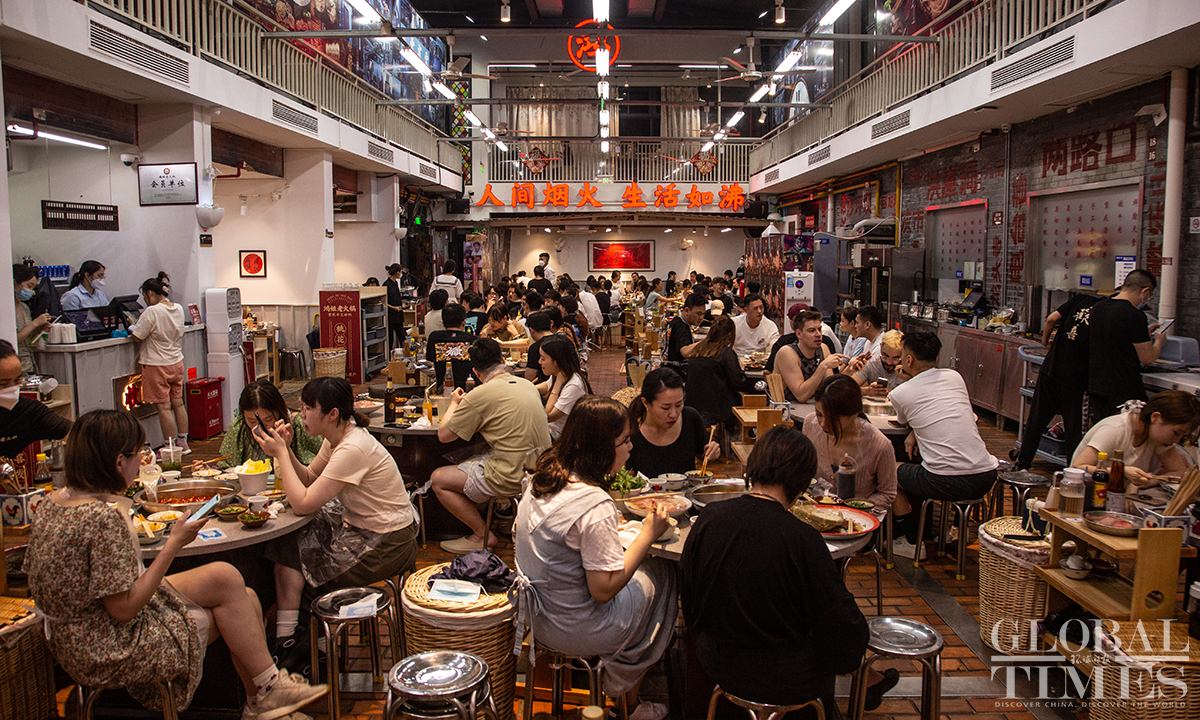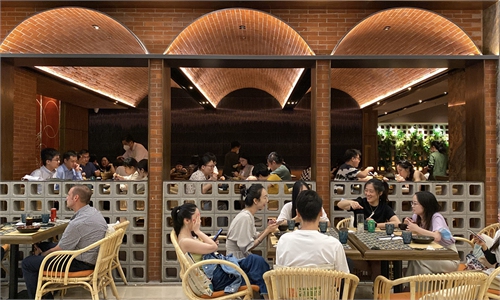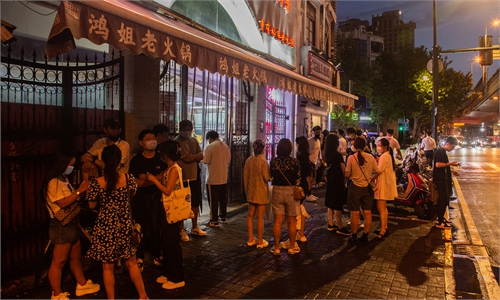Shanghai restaurants resume dining-in service, business revenue up 293 percent
Stores call for high-end food ingredients needed by local foodies

On the first night of Shanghai resuming dine-in services on June 29, 2022, it took 3 hours to queue to dine at a hotpot restaurant on Dingxi Road, Yan'an West Road, Changning District. Photo: Wu Shiliu/GT
Restaurants in Shanghai reopened doors to diners on Wednesday after dining-in service was suspended for about three months due to an Omicron outbreak, bringing most high-end, expensive ingredients for the foodies in Shanghai and adding fresh momentum to consumption recovery.A representative from a Japanese restaurant in downtown Jing'an district told the Global Times that they have prepared many advanced ingredients such as imported peony shrimp and sea urchins as before the recent epidemic outbreak to ensure supply for picky foodies.
"We have received a lot of reservations from customers for the weekend. We will do our best to meet their demand," the representative said.
At 10 am on Wednesday, a Starbucks location in Huangpu district is almost full with its first flock of dining-in customers in months, as local residents surge back to enjoy coffees and other foods.
"Our 10,000 partners are excited to welcome customers back to Starbucks, as we resume dining-in services in 800 stores within 48 hours. It's Starbucks modest contribution to help Shanghai customers return to their pre-outbreak routines and lifestyles, and get the city back to its usual buzz and vibrancy," Starbucks China chief executive officer Leo Tsoi said in a statement sent to the Global Times on Wednesday.
The return of Shanghai dining-in service may trigger a new wave of consumption of high-end food ingredients and assist to boost the recovery of the catering industry in China, as it is among the top Chinese cities when it comes to spending power for expensive food ingredients, Zhu Danpeng, a veteran food industry observer, told the Global Times.
Shanghai has allowed restaurants to resume onsite business in low-risk areas where no outbreaks have occurred in the past week from June 29.
On its first day of resuming dining-in service, onsite turnover at restaurants has rose 293 percent compared with the previous week, according to data provided by Meituan.
Among them, dining at Japanese restaurants surged by more than 252 percent from last week as the top choice for many as their first meal which is followed by hot pot, Cantonese cuisine and buffets.
In a shopping mall in Jing'an district, restaurants providing work lunch for white-collar workers have resumed their usual hustle and bustle and recovered to around 80 percent of its usual traffic, the Global Times observed.
At a Cantonese dim sum store, the Global Times saw there are already several patrons waiting for tables. Inside, the waiters were trotting to take orders, clear tables and help guests get seated.
"We did not expect so many people on the first day. We are running out of hands," a waiter in the store told the Global Times on Wednesday.
A diner waiting in the line said that it was her first sit-down meal in months. "It feels good. To celebrate, me and my colleagues have planned to order a lot," she said.
Nearby, a waiter from a local hotpot chain told the Global Times that the seats were already fully occupied at the moment and also booked in the evening.
In order to meet the COVID-19 prevention requirements, the local commission of commerce has instructed restaurants to maintain distance between tables. Large-scale restaurants must cap their tables at 70 percent of their capacity, while smaller restaurants are ordered to operate at 50 percent capacity.
The waiter from the hotpot store said they suggested the diners to finish their meal within 90 minutes as advised by the local industry association, which is not mandatory.
"It is expected that more areas will be opened to diners as the epidemic situation improves," the waiter said.
Some restaurants, however, have not resumed on-site meal or remained closed. Some staff told the Global Times that they were still waiting for notice from local food and drug administration and others said they would not resume in-store service for the time being due to shortage of hands.
"It is expected the business will pick up and restore to its normal level in mid-July," Zhu said.



